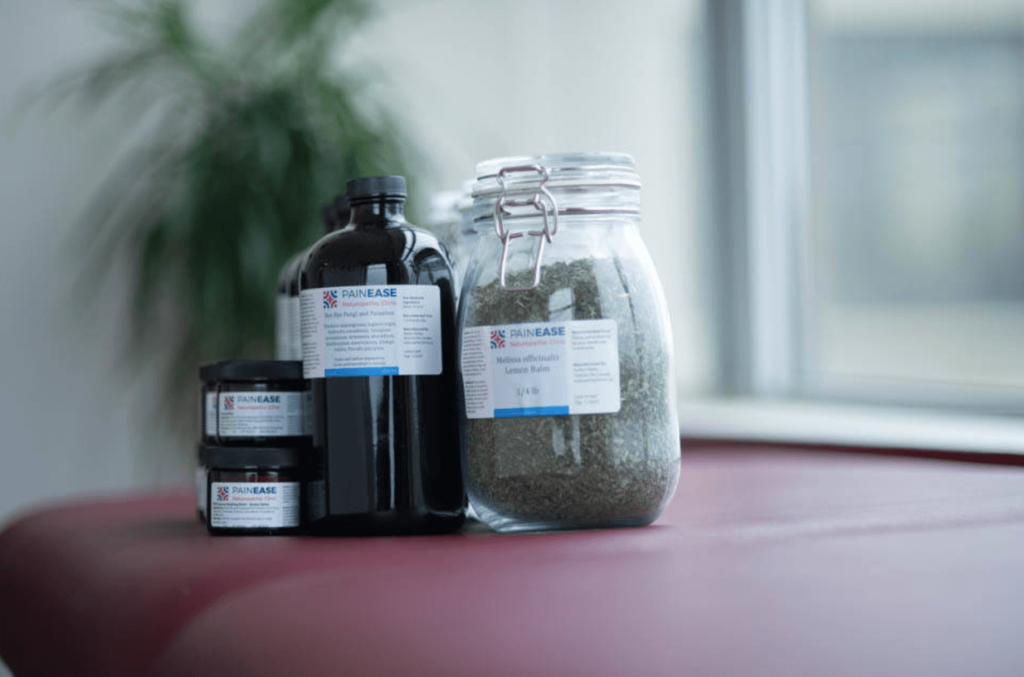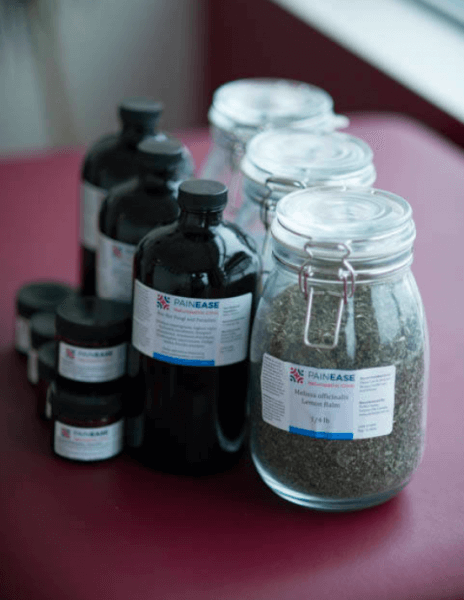Address:
470 Bronte St S Suite 202 Milton, Ontario L9T 2J4 Canada
BOTANICAL & HERBAL MEDICINE
Evidence from archaeological studies shows that botanical medicine has been used by humans since the Paleolithic era, which was 60,000 years ago! Herbal medicine has been used in many societies and cultures throughout time and the traditional knowledge is still used today with scientific studies providing more and more evidence regarding how these plants work. Many well-known pharmaceutical drugs are derived from plants, and herbs can be very effective in treating many common conditions.
What is Botanical Medicine?

Botanical medicine, also known as herbal medicine, uses medicinal plants and extracts to treat conditions and promote the body’s ability to heal. Traditional herbalism has been practiced throughout human history. Modern herbalism uses evidence-based science along with this traditional knowledge to provide safe and effective treatments that work with your body in a holistic way, treating the root cause of illness to help you heal.
The plant kingdom is an incredibly diverse kingdom, and the medicines that come from plants are just as diverse. Many plants contain substances that act on receptors in our brains and bodies, and many pharmaceutical drugs were originally derived from plant constituents (read more about constituents below). Some of these molecules are used in their original plant form as both prescription medications and in hospitals. Examples include:
- Morphine – a painkiller alkaloid from the opium poppy (Papaverus somniferum), the first commercial natural product marketed for therapeutic use in 1826
- Atropine – an alkaloid from a deadly nightshade (Atropa belladonna) and other nightshades that is listed in the WHO’s model list of essential medicines. It is used to dilate pupils, and in many hospital situations to increase heart rate, and to counter the effects of organophosphate poisoning
- Digoxin – a cardiac glycoside from foxglove (Digitalis purpurea) used to treat heart failure
Other plant compounds have been developed into semi-synthetic, patentable versions. Examples of these kinds of compounds include:
- Acetylsalicylic acid (Aspirin) – a semi-synthetic anti-inflammatory compound based on extracts from the willow tree, Salix alba
- Paclitaxel – a drug used to treat cancer based on extracts from the Yew tree, Taxus brevifolia
- Artemotil – based on a compound found in Chinese wormwood, Artemisia annua, a new drug used in treatment-resistant malaria
These are just a few examples of many, many drugs that have a basis in plants. While isolating these compounds and using them as drugs can be very effective for certain kinds of therapies, using whole herb extracts can be both a gentler and more powerful way of treating many conditions.
Medicinal plants contain a number of active compounds that act in synergy with each other. Sometimes this means the whole plant extract is much more effective than individual chemicals within the plant. Other times the additional compounds function to smooth out the effect of the main chemical, which can translate to fewer side effects than if you were to use pharmaceutical drugs.
For example, berberine (an alkaloid constituent from Goldenseal.) is often credited as the important chemical in plants it’s found in, but berberine on its own doesn’t work to inhibit antibiotic resistance. However, whole plant extracts from these plants do stop antibiotic resistance, meaning superbugs like MRSA can actually be eradicated using a combination of these herbal medicines and prescription antibiotics.
Other times two different plants given together are more effective than either plant on its own. St. John’s wort, a plant that has activity similar to prescription antidepressants, works better with added Passionflower than it does on its own. Combining these two plants is a more effective way to treat depression and anxiety than either plant by itself.
How do Naturopathic Doctors use Herbal Medicine?
There are thousands of medicinal plants in the world and many cultures have systems of using herbs for medicine. When choosing an herb or blend of herbs to treat medical conditions, naturopathic doctors are trained in Western Herbalism, a practice which focuses on herbal actions and constituents.
An action is the way an herb works in the body. Many herbal actions are comparable to actions of pharmaceutical drugs, and in fact, many pharmaceuticals are made from plant-derived compounds! Some of these actions include anti-inflammatory, antibacterial, and anxiolytic (anti-anxiety). There are also actions that are specific to herbalism, such as adaptogenic (helps the body respond to stress) and tonic (helps nourish the body).
Constituents are the other part of the formula. Constituents are plant chemicals that have medicinal properties. These are the main chemical extracts that are often made into drugs, like some of the ones listed above. There are many classes of constituents, and herbs are often grouped into categories based on what constituents they contain. Examples of this would be:
- Caffeine (an alkaloid), which is one of the main stimulant constituents found in coffee
- Curcumin (a phenol), the main anti-inflammatory constituent found in turmeric
- Ginsenosides (saponins), the active chemicals in ginseng
Each plant is unique in its composition of constituents. Their unique profile can be used to match constituents to symptoms and causes of illness in a very specific and individualized way. Naturopathic doctors choose herbs that have the right combination of constituents and actions to treat the cause of illness, minimize drug interactions, and use doses that have therapeutic benefit.
How are Herbal Medicines Administered?

Herbal medicines can be taken in a number of uncomplicated and easy ways. The right way for you will depend on which herbs are being used, what they’re being used for, and what application best fits into your lifestyle.
Herbal Tinctures
Tinctures are extracts of medicinal plants in alcohol or glycerin. They usually contain a custom blend of 3-5 different plants and are great when a high concentration of herbs are required. Tinctures also allow you to taste the plants in your unique remedy, and connecting to nature and plants as medicines can be therapeutic in itself.
Standardized Extracts
Standardized extracts are simple herbs in a pill form. These herbs are usually highly concentrated and contain doses of herbal constituents that are known to work,. These pills can either contain a single herb or a blend of herbs, and are formulated to provide the most effective dosing of the active plant chemicals.. Another great thing about standardized extracts is that they are great for busy people – it’s easy to take pills throughout the day, and for when frequent or high doses of the herbs are required.
Teas
Teas are a gentle and effective way to administer herbal medicines. They’re not usually as strong as tinctures or extracts, so drug interactions are minimal. Medicinal teas contain a custom blend of herbs, and some patients love taking the time to prepare their own medicine and create their own ritual. Teas are very comforting, making them especially good for anxiety or stress-related conditions.
Topical Applications
Herbs can be applied topically in the form of lotions (liniments), ointments (salves), and poultices. These often smell great, and allow us to use herbs that are dangerous if taken internally – like arnica and comfrey – but excellent when used externally. Topical applications are a great way to help heal cuts, bruises, and infections because they help get a strong dose of botanical medicine right to where it’s needed.
Can Botanical Medicine Help Me?
Botanical medicines are powerful, natural substances that can be used as part of a treatment plan for many conditions. With their experience and extensive clinical training, naturopathic doctors are experts in knowing how to use herbal medicines safely while maximizing their effectiveness. Choosing the right plants for an individual case is an art, and we love being able to directly use the healing power of nature by using plants as part of your treatment plan.
Because herbs have mechanisms of actions that are very similar to prescription drugs, they can also be very helpful in reducing doses of medications, and reducing side effects when coming off of medications. If you’re planning on reducing or quitting a drug, ask us how herbal medicine can help.
Discover the powerful and natural herbal medicine for your treatment plan! Book now an appointment to see us!
Get In Touch
Whether you're looking for a complimentary consult or a you're regular patient, you can select the right appointment that fits your schedule.
Ask us a Question Make an AppointmentPain Ease Naturopathic Clinic
470 Bronte St S Suite 202
Milton, Ontario L9T 2J4 Canada
Phone: 1 (647) 361-4187
Fax: (647) 361-4187
Email: info@painease.ca
Locations
Even though our clinic is in Milton, our patients come from all over the GTA. Click below to learn more.
Mississauga, Oakville, Burlington, Brampton, Halton Hills, Hamilton
Connect With Us
If you’re ready to become a patient, or if you’re curious about how we can help you optimize your health, please click on the respective button below.
